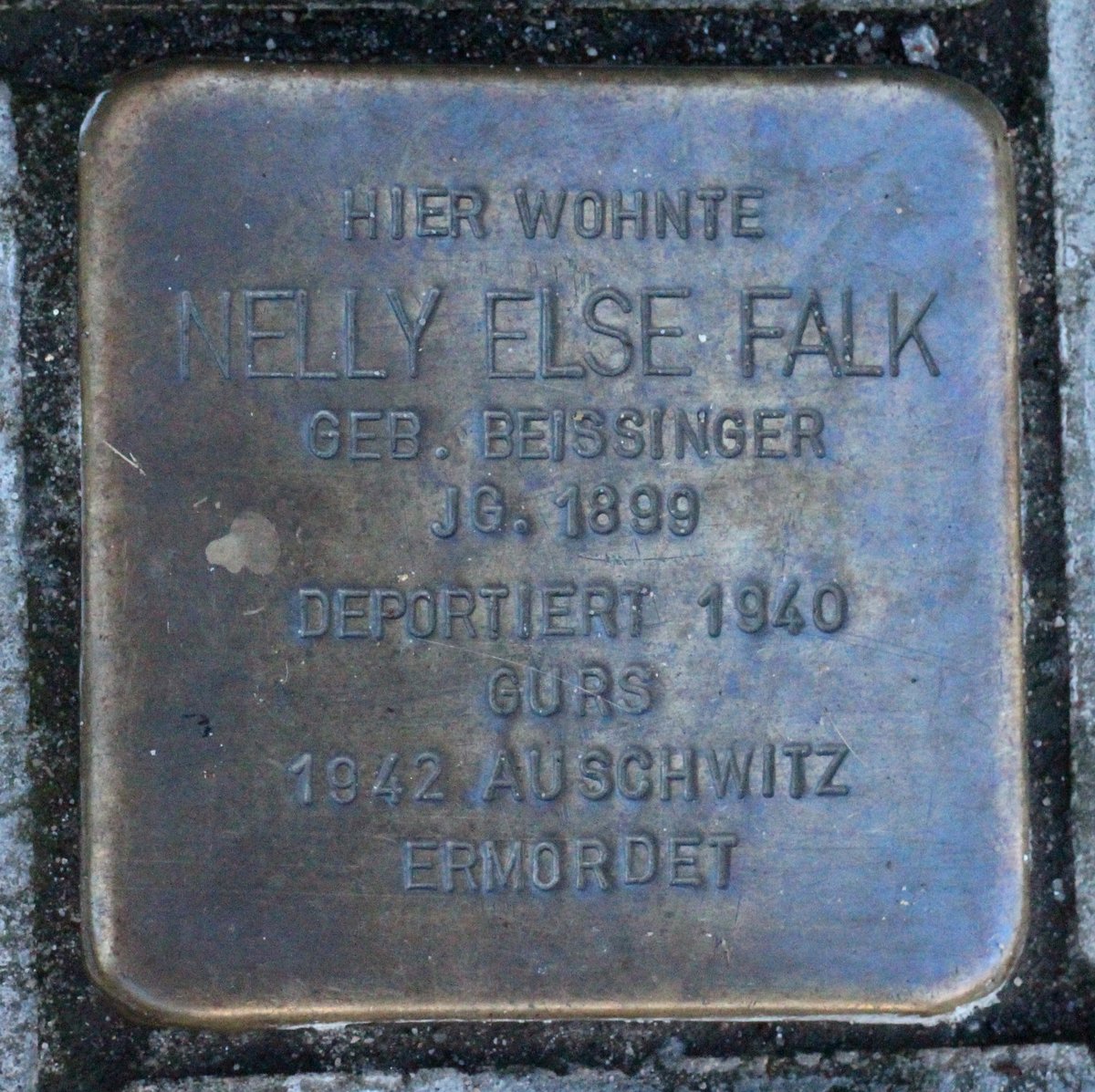
Stolperstein Nelly Else Falk Karlsruhe: Visiting Hours, History, and Significance
Date: 14/06/2025
Introduction: Remembering Nelly Else Falk in Karlsruhe
The Stolperstein dedicated to Nelly Else Falk in Karlsruhe offers a poignant encounter with the history of the Holocaust. Stolpersteine, or “stumbling stones,” are small brass plaques embedded in sidewalks, marking the last freely chosen residences of victims of Nazi persecution. This decentralized memorial integrates remembrance into everyday life, prompting reflection and education. This guide provides comprehensive information about Nelly Else Falk, the Stolperstein project, visiting details, and related historical sites in Karlsruhe.
About Nelly Else Falk and Her Stolperstein
Nelly Else Falk (née Beißinger), born in 1899 in Gondelsheim near Bretten, lived with her husband, Hermann Falk, a co-owner of a leather wholesale business, at Bahnhofstraße 8 in Karlsruhe. After her husband’s death in 1929, Nelly and her son, Walter, continued to reside there. The escalating Nazi persecution forced them to move in with Nelly’s parents after their home was ransacked during Kristallnacht in 1938 (Gedenkbuch Karlsruhe). Nelly secured her son’s safety through the Kindertransport, but she was deported to Gurs internment camp in France in 1940, and later murdered in Auschwitz in 1942 (Find a Grave). The Stolperstein at Bahnhofstraße 8 commemorates her life and tragic fate.
Visiting the Stolperstein: Location, Hours, and Accessibility
- Location: Bahnhofstraße 8, Karlsruhe, Germany.
- Visiting Hours: Accessible 24/7. Stolpersteine are embedded in the public sidewalk.
- Accessibility: Generally wheelchair accessible as part of the sidewalk. However, it is advisable to check specific route accessibility information if needed.
- Cost: Free.
Guided Tours and Further Exploration
Several organizations offer guided Stolpersteine tours in Karlsruhe, providing historical context and personal stories. Check with the local tourism office (Karlsruhe Tourism Official Website) or the Förderverein Karlsruher Stadtgeschichte e.V. (Stolpersteine Karlsruhe) for details. Digital resources like the Audiala app offer audio guides and interactive maps.
Consider combining your visit with other nearby historical sites:
- Karlsruhe Palace and Museum: (Karlsruhe Tourism Official Website)
- Jewish Museum Karlsruhe: (Jewish Museum of Baden)
- Other Memorials and Monuments: Karlsruhe has several Holocaust and World War II memorials.
The Stolpersteine Project: Origins, Purpose, and Impact
The Stolpersteine project, initiated by German artist Gunter Demnig, began in 1992 and aims to personalize Holocaust remembrance. Each stone, a 10x10 cm concrete cube topped with a brass plate, is inscribed with the victim’s name, date of birth, and fate (Stolpersteine.eu; Wikipedia). By June 2023, over 100,000 stones had been placed across Europe (Wikipedia; Prague Views). This decentralized approach brings history into everyday life, reminding us of the individuals behind the statistics.
Community Involvement and Maintenance
Local communities play a crucial role in the Stolpersteine project, sponsoring stones, organizing installations, and maintaining them. Volunteers regularly clean the stones, ensuring the names remain visible and the memories alive (Prague Views). This ongoing community engagement sustains the project’s impact and fosters a culture of remembrance.
Conclusion: A Call to Remembrance
Visiting the Stolperstein for Nelly Else Falk offers a powerful and personal way to engage with Holocaust history. It’s a reminder of the individual lives lost and the importance of preserving their memory. By visiting these memorials, we contribute to a collective act of remembrance and ensure that the stories of the victims are never forgotten. Utilize online resources like the Stolpersteine Guide and local tourism websites for additional information and planning your visit.
























































































































































































